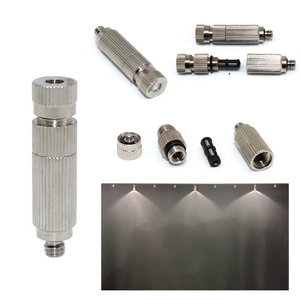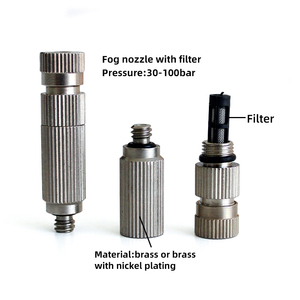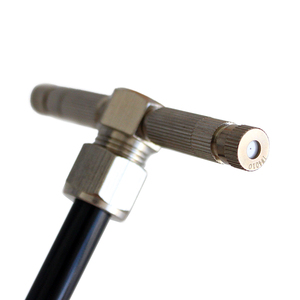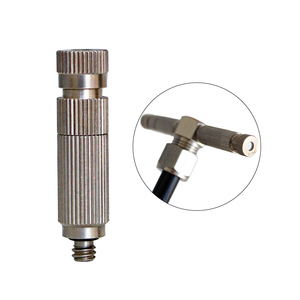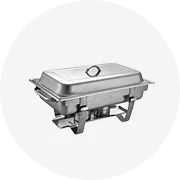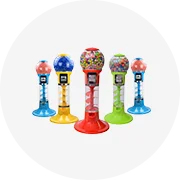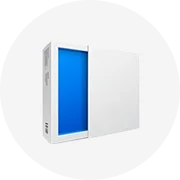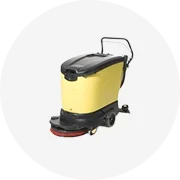Types of Cooling China Nozzles
A Cooling China nozzle is a crucial component in industrial and manufacturing systems, primarily used for efficient heat dissipation and thermal management. These nozzles are widely used across sectors such as electronics, laser cutting, 3D printing, and heavy machinery to ensure optimal operational temperatures and prevent overheating. Below is an overview of the major types of cooling nozzles produced in China, along with their applications and performance characteristics.
Copper Cooling Nozzle
Renowned for its excellent thermal conductivity, the copper cooling nozzle is commonly used in precision manufacturing environments like 3D printing. These nozzles come in various sizes and can be customized based on filament type and model complexity, making them versatile tools for producing high-quality prints.
Advantages
- High thermal conductivity
- Customizable designs
- Improves print quality and detail
- Durable under standard operating conditions
Limitations
- Heavier than other materials
- Potential oxidation over time
- Higher cost compared to plastic alternatives
Best for: 3D printing applications, detailed prototyping, professional engineering work
Liquid Cooling Nozzle
Liquid cooling nozzles utilize water or specialized coolants to manage heat in high-temperature industrial environments. They are essential in processes like laser cutting, material processing, and dust suppression, where rapid heat transfer and surface cleaning are required.
Advantages
- Superior cooling efficiency
- Effective debris removal
- Multifunctional use (cooling + humidification)
- Essential for high-intensity operations
Limitations
- Requires fluid supply infrastructure
- Potential for leaks or corrosion
- Higher maintenance needs
Best for: Laser cutting, industrial machining, high-heat manufacturing
Cooling Air Nozzle
Designed to deliver focused streams of compressed air, these nozzles are ideal for spot cooling electronic components, production lines, and inspection stations. By enhancing convective heat transfer, they help maintain safe operating temperatures while reducing energy consumption and downtime.
Advantages
- Energy-efficient operation
- Low maintenance requirements
- Fast and effective cooling
- Versatile across industries
Limitations
- Dependent on compressed air systems
- Noise from high-speed airflow
- Limited effectiveness in extreme heat
Best for: Electronics cooling, automated manufacturing, product testing environments
| Type | Cooling Efficiency | Material Compatibility | Maintenance Level | Typical Applications |
|---|---|---|---|---|
| Copper Cooling Nozzle | Good | Excellent (with filaments) | Low | 3D printing, prototyping, design studios |
| Liquid Cooling Nozzle | Excellent | Good (with coolant systems) | Moderate | Laser cutting, machining, dust control |
| Cooling Air Nozzle | Fair to Good | Excellent (non-contact) | Very Low | Electronics, assembly lines, QA inspections |
Expert Tip: For optimal performance, regularly inspect liquid cooling nozzles for mineral buildup or clogging, especially when using tap water. Consider installing filtration systems to extend nozzle lifespan and maintain consistent cooling efficiency.
Specifications and Maintenance of Cooling China Nozzles
Cooling nozzles play a crucial role in industrial manufacturing processes. These components ensure optimal thermal regulation by delivering precise cooling to machinery or products during production. Even minor deviations in nozzle performance can lead to costly downtime, inconsistent product quality, or equipment damage. Understanding the technical specifications and proper maintenance practices for cooling nozzles is essential for maximizing operational efficiency and prolonging component lifespan.
Key Specifications to Consider
Selecting the appropriate cooling nozzle involves evaluating several critical factors that directly impact its functionality and compatibility with specific applications. The following specifications should be carefully assessed before making a purchase decision:
Nozzle Material Composition
Most cooling nozzles are fabricated from stainless steel due to its excellent corrosion resistance and ability to withstand high-pressure environments. This makes them ideal for heavy-duty industrial applications where durability and reliability are paramount.
In more demanding conditions involving abrasive materials or extreme wear, tungsten carbide nozzles offer superior hardness and longevity. These specialized materials maintain their structural integrity even under continuous exposure to harsh operating environments.
Nozzle Dimensions
The physical size of a cooling nozzle significantly affects both flow rate and droplet dispersion characteristics. Smaller diameter nozzles generate finer mists that facilitate rapid heat dissipation, making them suitable for precision cooling applications such as laser cutting or electronics manufacturing.
Larger nozzles provide broader coverage patterns and higher volume output, which is beneficial for applications requiring gradual cooling over larger surface areas, such as metal casting or large-scale molding operations.
Nozzle Design Variants
Cooling nozzles come in various designs tailored to specific functional requirements. Atomizing nozzles produce ultra-fine mist particles that maximize evaporative cooling effects, making them ideal for temperature-sensitive processes.
Air-assisted nozzles combine compressed air with liquid coolant to enhance spray dispersion and cooling efficiency. These designs are particularly effective in applications where water conservation is important or where precise directional control is required.
Operating Pressure Requirements
Cooling nozzles are engineered to operate at different pressure levels depending on the intended application. High-pressure systems produce uniform droplet sizes that ensure consistent cooling across targeted surfaces, which is crucial for maintaining dimensional accuracy in precision manufacturing.
Low-pressure systems may be preferred in applications where gentle cooling is necessary to avoid disturbing delicate components or compromising product integrity during the cooling phase.
Temperature Control Features
Advanced cooling nozzles often incorporate temperature regulation mechanisms to maintain precise thermal management. These features allow for automated adjustments based on real-time process parameters, ensuring optimal cooling performance throughout production cycles.
For instance, in plastic injection molding, maintaining uniform mold temperatures through controlled cooling prevents warping, shrinkage, and other defects. Integrated temperature sensors and feedback systems help achieve this level of precision.
| Specification | Importance Level | Selection Guidance |
|---|---|---|
| Material Type | High | Select stainless steel for general use; choose tungsten carbide for high-wear environments |
| Nozzle Diameter | High | Smaller diameters for fine mist/rapid cooling; larger diameters for broad coverage/slower cooling |
| Spray Pattern Type | Medium | Fan patterns for wide area coverage; full cone for volumetric cooling applications |
| Pressure Rating | High | Match pressure requirements to system capabilities and desired droplet consistency |
Essential Maintenance Practices
To ensure continuous, trouble-free operation and extended service life, cooling nozzles require regular maintenance attention. Proper care not only preserves performance but also helps prevent unexpected failures that could disrupt production schedules:
Important: When replacing one cooling nozzle, consider inspecting and potentially replacing all nozzles within the same system to maintain uniform performance characteristics. Mismatched nozzles can create uneven cooling patterns that compromise process stability and product consistency.
How to Choose Cooling China Nozzle
Selecting the right cooling nozzle is crucial for optimizing thermal management in manufacturing processes such as injection molding and metal forming. The correct nozzle enhances part quality, reduces cycle times, and improves system efficiency.
Cooling Requirements
The specific cooling needs of your production process are foundational to selecting the appropriate nozzle. These requirements depend on multiple variables including material properties, part geometry, and production throughput. Complex geometries or materials with high thermal mass (like certain metals or engineering plastics) demand nozzles that can deliver higher cooling capacity to ensure uniform heat dissipation.
- High-performance polymers often require precise temperature control to prevent warping or shrinkage
- Metal casting applications may need high-flow nozzles for rapid heat extraction
- Simpler parts made from low-melting-point materials might perform well with standard cooling intensity
Key consideration: Evaluate both peak and average cooling demands across your production cycles
Nozzle Design
Nozzle design significantly impacts cooling performance by influencing airflow dynamics, heat transfer rates, and temperature uniformity across the mold surface. Advanced designs incorporate features that enhance turbulence and maximize contact area between the coolant and mold surface.
- Micro-channel nozzles increase surface area contact for improved heat exchange
- Pin array configurations disrupt laminar flow to promote more effective cooling
- Adjustable aperture designs allow customization of airflow direction and intensity
- Swirl-inducing internal structures improve cooling coverage
Design tip: Look for computational fluid dynamics (CFD)-optimized profiles for maximum efficiency
Compatibility
Ensuring proper compatibility between the cooling nozzle and your existing equipment is essential for seamless integration and optimal performance. The nozzle must interface correctly with your machine's ports, cooling circuits, and control systems while maintaining chemical and mechanical compatibility with the cooling medium.
- Standardized thread sizes facilitate easy installation
- Modular designs enable interchangeability across different machines
- Material compatibility ensures longevity when using corrosive coolants
- Thermal expansion characteristics should match connected components
Installation benefit: Quick-connect fittings reduce maintenance downtime
Material and Coatings
The construction materials and surface treatments of cooling nozzles directly affect their performance characteristics, service life, and resistance to environmental factors. High-conductivity materials improve heat transfer efficiency, while protective coatings extend component lifespan under demanding conditions.
- Copper alloys offer excellent thermal conductivity but may require corrosion protection
- Stainless steel provides durability in harsh environments
- Teflon coatings reduce fouling and improve flow characteristics
- Anodized aluminum offers lightweight performance with enhanced wear resistance
Performance factor: Surface finish affects flow turbulence and heat transfer efficiency
Maintenance and Cleaning
Effective maintenance strategies are vital for sustaining optimal cooling performance over time. Nozzles exposed to continuous operation or aggressive coolants can develop mineral deposits, biological growth, or particulate buildup that diminishes effectiveness.
- Self-cleaning designs minimize residue accumulation
- Modular construction enables quick disassembly for cleaning
- Corrosion-resistant materials reduce long-term degradation
- Transparent housings allow visual inspection without removal
Preventative measure: Establish regular cleaning intervals based on water quality and usage patterns
Cost and Performance
While initial acquisition cost is an important consideration, total cost of ownership provides a more comprehensive evaluation framework. High-performance nozzles may command premium pricing but often deliver substantial returns through energy savings, improved part quality, and reduced downtime.
- Entry-level nozzles offer basic functionality at lower upfront costs
- Mid-range options balance performance and value for general applications
- Premium models provide specialized features for demanding environments
- Custom solutions optimize performance for unique applications
Value equation: Consider energy savings, scrap reduction, and production uptime gains
Selection Advice: When upgrading cooling systems, consider implementing a phased approach starting with critical areas that will benefit most from improved thermal management. Monitor performance metrics before and after implementation to quantify improvements and guide future investments.
| Application Type | Recommended Nozzle Feature | Optimal Material | Expected Benefit |
|---|---|---|---|
| Plastic injection molding | Adjustable swirl design | Anodized aluminum | Improved dimensional stability and shorter cycle times |
| Metal die casting | High-flow micro-channel | Copper alloy with nickel plating | Enhanced thermal fatigue resistance and longer tool life |
| Extrusion processing | Uniform spray pattern | Stainless steel | Better surface finish and reduced cooling variation |
| 3D printing systems | Compact precision design | Graphite composite | Improved layer adhesion and reduced warping |
How to DIY and Replace a Cooling China Nozzle
Replacing a cooling nozzle, particularly a China-made nozzle used in industrial or automotive cooling systems, is a relatively straightforward task when approached methodically. These nozzles play a crucial role in directing coolant flow to maintain optimal temperatures in machinery or engines. While the exact process may vary slightly depending on the system's design, following these comprehensive steps will help you replace your cooling nozzle efficiently and safely.
Safety Warning: Always ensure the cooling system is completely depressurized and powered down before beginning work. Wear protective gloves and eyewear to prevent injury from coolant splashes or sharp edges.
Detailed Replacement Guide for Cooling Nozzles
- Gather Tools and Materials
- New compatible cooling nozzle (ensure it matches the specifications of the original)
- Wrench set or socket set appropriate for the fittings
- Screwdrivers (flathead and/or Phillips, as needed)
- Hose clamps (if required for reassembly)
- Gasket material or high-temperature sealant (for sealing connections)
- Rags or paper towels for cleaning spills
- Container to catch residual coolant
- Turn Off and Depressurize the System
- Shut off the power supply to the cooling system to avoid electrical hazards.
- Close any water inlet valves or disconnect the main water supply line if applicable.
- Open pressure release valves or bleed screws to relieve any built-up pressure in the system.
- Drain the Cooling System
- Locate the drain plug or valve on the radiator or reservoir tank.
- Place a container underneath to collect the coolant, disposing of it properly according to local regulations.
- If complete drainage isn't necessary, at least lower the coolant level below the nozzle installation point to minimize spillage.
- Remove the Old Nozzle
- Loosen and remove bolts, screws, or hose clamps securing the old nozzle to the system.
- Carefully extract the nozzle while avoiding damage to adjacent components such as hoses, pipes, or brackets.
- If the nozzle is stuck due to corrosion or buildup, apply penetrating oil and allow time for it to loosen before forcing removal.
- Prepare the Installation Area
- Inspect the pipe or fitting where the new nozzle will be installed for wear, cracks, or corrosion.
- Thoroughly clean the surface using a cloth or mild degreaser to remove old gasket residue, dirt, or coolant deposits.
- If necessary, apply a thin layer of high-temperature silicone sealant or install a new gasket to ensure a leak-free connection.
- Install the New Cooling Nozzle
- Align the new nozzle with the pipe or mounting bracket, ensuring it faces the correct direction for optimal coolant spray pattern.
- Secure the nozzle using the appropriate fasteners, tightening them evenly to avoid warping or cracking the nozzle body.
- If connected via hose, install new hose clamps and tighten securely but not excessively to prevent hose damage.
- Reconnect Associated Components
- Reattach any hoses, brackets, or wiring that were disconnected during removal.
- Double-check all connections for tightness and proper alignment.
- Replace any panels or covers removed for access to the nozzle area.
- System Test and Leak Check
- Refill the cooling system with the recommended type and amount of coolant.
- Start the system and observe the new nozzle’s operation, checking for consistent spray pattern and coverage.
- Monitor all connections for leaks and address any issues immediately.
- Run the system under normal operating conditions for several minutes to confirm stability and performance.
| Stage | Key Actions | Potential Issues | Recommended Tools |
|---|---|---|---|
| Preparation | Assemble tools, verify nozzle compatibility | Mismatched nozzle size, missing tools | Socket set, screwdrivers, flashlight |
| Disconnection | Power off, drain coolant, remove old nozzle | Leakage, damaged fittings | Adjustable wrench, pliers, coolant jug |
| Installation | Mount new nozzle, secure with fasteners | Improper alignment, cross-threading | Gasket scraper, sealant, torque wrench |
| Testing | Refill, restart system, check for leaks | Inadequate spray, persistent leakage | Funnel, gloves, safety glasses |
DIY Tip: Before installing the new nozzle, test-fit it without fastening to ensure proper positioning and spray angle. This helps avoid rework and ensures efficient cooling performance right from the start.
Additional Considerations
For best results, always refer to the manufacturer’s maintenance manual for specific instructions related to your cooling system model. Regular inspection and timely replacement of cooling nozzles can significantly extend the life of your equipment by maintaining effective thermal management. If you encounter resistance during removal or notice unusual wear patterns on the old nozzle, consider inspecting the entire cooling circuit for blockages or excessive buildup.
Frequently Asked Questions About Cooling Nozzles in Injection Molding
A1. The cooling nozzle plays a crucial role in the injection molding process by efficiently managing thermal regulation during production. Key benefits include:
- Reduced cycle time: By accelerating the cooling of molten plastic, the overall manufacturing cycle becomes faster, improving throughput.
- Improved product quality: Uniform and controlled cooling minimizes warping, shrinkage, and other defects in the final molded part.
- Increased productivity: Faster cooling allows for more parts to be produced within the same timeframe, enhancing operational efficiency.
- Energy efficiency: Optimized cooling reduces the need for excessive energy consumption while maintaining process integrity.
These advantages make cooling nozzles essential for high-performance injection molding applications where precision and repeatability are critical.
A2. Cooling nozzles are widely applicable across various types of injection molding processes but are especially beneficial in operations that demand precise temperature control and efficient heat dissipation. They are commonly used in:
- Thermoplastic injection molding: Where rapid cooling helps maintain dimensional accuracy.
- Multi-cavity molds: Ensuring uniform cooling across all cavities to prevent inconsistencies.
- High-precision engineering plastics: Materials like polycarbonate or nylon that require careful thermal management to avoid defects.
Cooling nozzles may be customized based on mold design, material properties, and production requirements to achieve optimal performance in each specific application.
A3. Cooling nozzles are typically constructed from industrial-grade materials selected for their durability, thermal conductivity, and resistance to corrosion. The most common materials include:
| Material | Properties | Typical Use Cases |
|---|---|---|
| Steel (Stainless Steel or Tool Steel) | High strength, excellent wear resistance, and long service life even under extreme conditions. | Ideal for high-pressure environments and molds requiring robust components that can withstand repeated cycles. |
| Aluminum Alloys | Lightweight with good thermal conductivity; easier to machine than steel. | Used in less demanding applications or when weight reduction is a priority, such as prototype molds or short-run productions. |
In addition to these base materials, some cooling nozzles may feature surface treatments or coatings to enhance corrosion resistance, reduce friction, or improve thermal performance depending on the operating environment.







